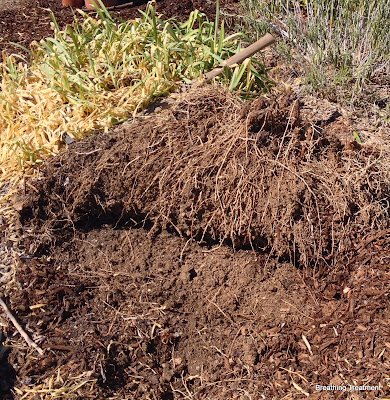You know it's fall when the bulbs start to poke their head above ground. Here I have an unknown exotic (bottom) that I enjoyed immensely last year and a few sprouts of Crocus sativus (saffron crocus - top) of which I have many pots. Perhaps this year they will bloom and I can give them as Easter gifts.
Of course, one sign of fall is ripping the Agapanthus (Lily of the Nile) out to make room for more interesting and important plants....
... I only wish it were a more universal sign of spring. Southern Californians could be forgiven for thinking Agapanthus is a native plant since it's used so widely in commercial and home plantings - the plants are green year round, tolerate the most vile garden conditions, bloom with distinctive and reasonably long-lived flowers, and don't succumb to disease or insect predation. In short, it's the perfect Borg plant. But I don't have a sterile and boring commercial garden and I want to encourage, not discourage, the insect food web (since I like birds, butterflies, other critters in my garden) and I want a California sense of place, so it's out with the Agapanthus and in with the natives.
In this filled-in pool, the wood chip mulch peels back with the Agapanthus root ball and it's rather easy to swing a mattock to pry out the roots, sending them to the landfill in the green barrel.*
Good riddance!
Then it's out with the poor performing plants. This root ball is from Ceanothus 'Tuxedo', a nearly black leaved Ceanothus that made its way from California to Ireland, where it hybridized, and then back to California. It's prone to mildew, and after searching the web I found that the home remedy of spraying dilute milk on the leaves really works wonders. However, the plant never did well, a fact I attributed to my late attention the mildew problem and I uprooted it from its roomy pot. Oh oh. It looks like it got a bit root bound at both the 1" or 2" pot level and at the 1 gallon size. This isn't the worst I've seen, and had I known it, I could have taken more extreme measures to help it along. This disappointment is that this Ceanothus was from a reputable local nursery that I still do business with.
*Don't be surprised - your green barrel is likely used as "alternative daily cover", not composted into mulch by long haired, vegetarian, herb-smoking, burnt out 60's era radicals now turned to urban composting. This is not a terrible use for it, since per good health practices something has to be used to cover garbage at the dump: You might as well use other garbage.





No comments:
Post a Comment